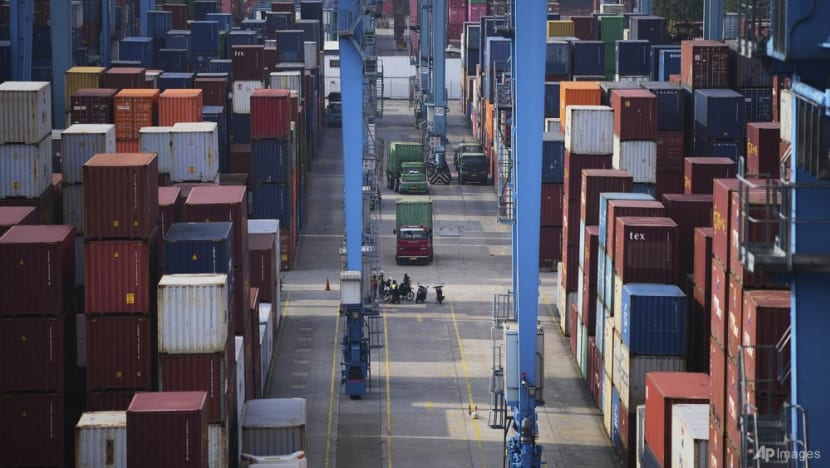Commentary: What ASEAN can do to help avoid the US taking the system down with it
The era of US leadership might be over, but it’s not the end of free trade, say economics professors Mari Pangestu and Shiro Armstrong.

Composite photo of the ASEAN flag and US President Donald Trump. (Photos: Reuters)

This audio is generated by an AI tool.
JAKARTA: The response to US tariffs from Southeast Asia has so far been a masterclass.
Asia’s success in integrating into global value chains – and being the most efficient producer of goods that the world wants and needs – meant that the region was hard hit by President Donald Trump’s so-called Liberation Day tariffs on Apr 2.
Indonesian President Prabowo Subianto, Malaysian Prime Minister Anwar Ibrahim and Singaporean Prime Minister Lawrence Wong were quick to declare they will not retaliate with tariffs of their own. That would merely add to the costs for citizens.
ASEAN Economic Ministers had already agreed in February to cooperate in the face of looming US tariffs and manage surges of Chinese imports locked out of the US market by using World Trade Organization-consistent trade remedies.
The ministers convened a special meeting on Apr 10 and created a taskforce to monitor developments and coordinate collective responses. A Special ASEAN Leaders’ Meeting will be convened, likely in early May.
This initial response reflects the structure of interests in Southeast Asia where development ambitions, prosperity and security have depended on open economies integrating into the global economy, including its giant Northeast Asian economic neighbours, the United States and Europe. The principles of openness, equality, cooperation and multilateralism are entrenched in the ASEAN DNA, even if not practised perfectly.
END OF RULES-BASED GLOBALISATION?
The 90-day pause on US tariffs buys some time. But the threat is far from over and things are likely going to get worse.
The US and China have locked horns, escalating the tariff rate to 145 per cent on all Chinese imports into the US and 125 per cent on all American goods entering China. The US-China trade relationship – until very recently the largest in the world – is decoupling rapidly.
The pressure will build massively on “connector” countries like those in Southeast Asia that are seen by the US now as the lengthening of China’s supply chain.
If the reciprocal tariffs are reinstated, they will lead to diverted trade, diverted investment and increasingly volatile capital flows, mixed with US policy uncertainty rocking global equity and bond markets.
It doesn’t stop there. The risk of tariff contagion and currency wars is growing, as is the danger of a race to devalue or depreciate currencies to make exports more competitive.
At risk is the rules-based international economic order. The current trajectory towards a world of “might is right” would threaten economic and political security globally, but especially in Asia.
But is the era of rules-based globalisation and free trade be over?
The era of US leadership might be over but the conclusion that it must lead to abandonment of global rules is premature.
Any single country may be powerless to reverse the trajectory but a US retreat from the system it led the creation of and enforced for 70 years need not be its end. Action by the rest of the world can help avoid the US taking the system down with it. It’s important to understand that the United States is now only 11 per cent of global trade.

WHAT ASEAN DOES NEXT
The next phase of ASEAN’s response will need to consider these global interests. It can help to fill a leadership vacuum in multilateralism. There are two principles that ASEAN already practises that can guide action and cooperation.
First, if ASEAN does what's in its interests consistent with its principles, that will contribute to global efforts to protect the rules-based multilateral trading system.
That includes avoiding retaliation that would just bring more economic pain, using measures consistent with rules and institutions ASEAN has committed to, and continuing to work as a group. Deviating from those guiding principles may unravel ASEAN.
Second is to protect and practise ASEAN centrality. ASEAN is not only central to its Southeast Asian member states, it is central to broader Asian cooperation. ASEAN should use its centrality, or risk losing it.
ASEAN will find willing partners in its own region. The foreign ministers of China, Japan and South Korea met a few days before the announcement of Mr Trump’s tariffs, agreeing to jointly respond to US tariffs and “to strengthen the implementation of RCEP”, referring to the Regional Comprehensive Economic Partnership, the 15-country free trade agreement that was created and is led by ASEAN.
The economic interests of Australia and New Zealand lie in Asia – they are members of RCEP and they too declared they will not retaliate against US tariffs. They share ASEAN’s deep interest in an open, rules-based multilateral system.
RCEP is the most promising of the ASEAN-centred institutions to coordinate broader collective action and resolve regional challenges like surges of Chinese imports.
NO GUARANTEES WITH US NEGOTIATIONS
Many countries hit by the reciprocal tariffs will try to negotiate with the US because of the adverse impact on their exports, growth and jobs, especially because the most impacted sectors tend to be labour-intensive. The White House will negotiate with countries one-on-one, but ASEAN countries will want to coordinate and avoid deals that harm ASEAN as a group.
Given the dynamics around Mr Trump’s tariff policy, this strategy will continue to be filled with uncertainties. Japan, one of the first to start formal talks with the US, has not reported much progress – and as a key US ally, represents the first real test of negotiation as a strategy.
What is happening in the US and its policies, is also leading to fears of recession, an adverse external environment and potential negative shocks.
The right response for ASEAN economies is a two-pronged strategy. First is to manage the external shocks by strengthening the domestic economy through appropriate macroeconomic policies, well-targeted programmes to address those impacted and a comprehensive package of deregulation and structural reforms. Doing so in tandem with neighbours will build confidence and bring larger benefits in Southeast Asia.
Second, by leveraging open regionalism and its centrality, the bloc can do more than protect its strategic interests. ASEAN can mobilise a coalition of willing partners to defend their interests in the multilateral system.
And Southeast Asia will be able to weather the biggest threat to its economic and political security since the creation of ASEAN.
Mari Pangestu is former Indonesia trade minister and Professor of International Economics at the University of Indonesia. Shiro Armstrong is Professor of Economics at The Australian National University.























